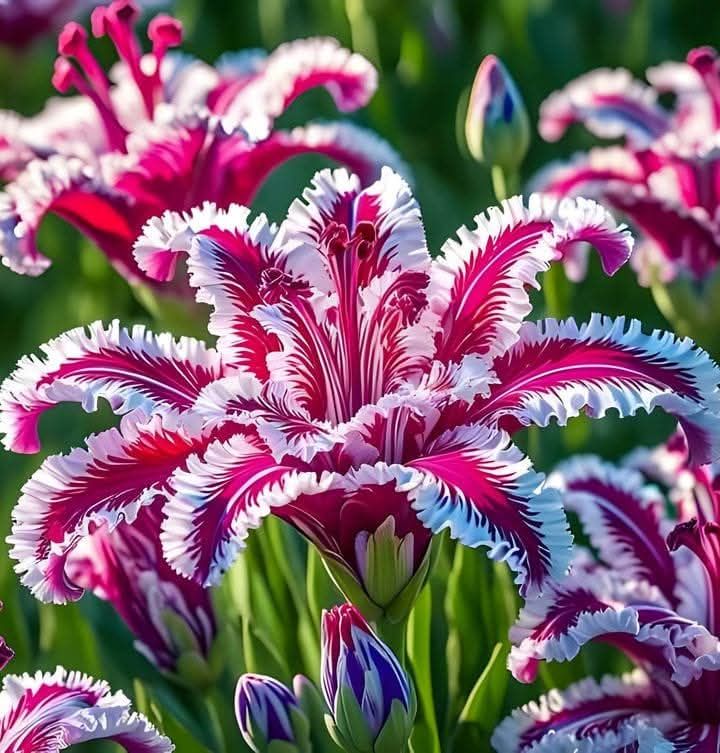If you’re looking to elevate your garden with a touch of exotic beauty and dramatic flair, Parrot Tulips (Tulipa ‘Parrot’) are a must-have. Known for their vibrant, ruffled blooms and unique, almost feathery petal structure, these tulips are sure to become the centerpiece of any garden. The striking combination of deep pinks, bright magentas, and delicate lavenders creates an eye-catching visual effect that commands attention, making them a favorite among gardeners and floral enthusiasts alike.
Description and Features
Parrot Tulips are renowned for their bold, large flowers, which appear almost like they belong to a different world. Each bloom is uniquely formed, with petals that are twisted, flared, and ruffled, giving them a distinctive feathery appearance. The vibrant colors—ranging from deep pinks and magentas to lavender hues—blend together in a stunning display of contrasts that make these tulips stand out in any garden.
The flower petals of Parrot Tulips are often fringed and irregularly shaped, creating a sense of movement and texture in the flower bed. Their exotic beauty can bring a touch of drama to any setting, whether planted in garden beds, borders, or containers.
These tulips are not only known for their stunning blooms but also for their long-lasting cut flowers, making them an excellent choice for floral arrangements. The unique ruffled texture and vibrant colors translate beautifully into indoor displays, where they can continue to enchant beyond the garden.
Growing Conditions for Parrot Tulips
Parrot Tulips are relatively easy to grow but thrive best under certain conditions. To ensure your Parrot Tulips grow healthy and vibrant, here’s a guide to their ideal growing requirements:
Light Requirements
Parrot Tulips thrive in full sun. To achieve the best blooming, plant them in a location where they can receive at least 6 hours of direct sunlight each day. Adequate sunlight will encourage strong stems and vivid blooms. However, in warmer climates, some afternoon shade can help protect the tulips from the heat, keeping the petals fresh and vibrant.
Temperature and Climate
These tulips flourish in moderate temperatures, ideally between 55-70°F (13-21°C). While they can tolerate cooler conditions in the early spring, it’s best to plant them in areas with a mild climate. In warmer climates, it’s best to plant Parrot Tulips in the fall so they can bloom in early spring, avoiding the extreme heat of summer.
They are hardy in USDA hardiness zones 3-7, making them ideal for regions with moderate winters and cool spring temperatures.
Soil Requirements
For optimal growth, Parrot Tulips prefer well-draining, nutrient-rich soil. Ensure the soil is loose and light, which will allow water to drain properly, preventing waterlogging that could cause bulb rot. Adding organic matter such as compost can improve soil structure and provide the necessary nutrients for healthy growth.
Tulips do best in soil that is slightly acidic to neutral (pH 6.0-7.0). It’s important to test the soil before planting and amend it if necessary. Adding sand or perlite can help improve drainage if you have heavy, clay-like soil.
Watering
Parrot Tulips require consistent watering but must not be waterlogged. Keep the soil moist but not soggy to prevent the bulbs from rotting. When planting, water the bulbs thoroughly, and then continue to water regularly during the growing season, especially during dry spells. However, it’s important to allow the soil to dry slightly between waterings, as tulips do not like to sit in damp soil for too long.
Once the blooms have faded and the foliage begins to yellow, reduce watering to encourage the bulbs to go dormant.
Fertilization
To promote healthy growth, apply a balanced, slow-release fertilizer in early spring as the bulbs begin to sprout. A balanced fertilizer with equal amounts of nitrogen, phosphorus, and potassium will help support both root and flower development.
Avoid over-fertilizing, as this can lead to excessive leaf growth at the expense of flowers. If needed, you can apply a second round of fertilizer after flowering to support bulb growth for next season.
Planting Parrot Tulips
Plant your Parrot Tulips in the fall before the first frost. This gives the bulbs time to establish roots before the colder winter months. Follow these simple steps for planting:
Choose a sunny location with well-draining soil.
Plant bulbs about 4-6 inches deep and 4-6 inches apart. The pointed end of the bulb should face upwards.
Cover the bulbs with soil and water thoroughly to settle them in place.
Mulch lightly around the area to help protect the bulbs over winter.
Maintenance and Care
While Parrot Tulips are relatively low-maintenance, they do require some attention to ensure they return year after year.
Deadheading: After the blooms fade, remove spent flowers to encourage the plant to focus its energy on bulb development.
Post-bloom care: Once the flowers are gone, let the foliage continue to grow and die back naturally. The leaves help nourish the bulb for next season’s growth.
Bulb care: Tulips typically bloom for 1-2 years before the bulbs may need replacing. However, if you are in an area with mild winters, you can leave the bulbs in the ground for several seasons.
Pests and Diseases
Tulips are generally resistant to pests, but aphids, slugs, and snails may occasionally cause trouble. Keep an eye on the foliage and blooms for signs of damage and use organic pest control methods if needed.
Tulips can also be susceptible to tulip fire (a fungal disease), which causes the flowers to appear scorched. Ensure proper air circulation around the plants to prevent the spread of disease.
Landscape Use
Parrot Tulips are excellent in a variety of garden settings, thanks to their striking visual appeal. Here are a few ideas for incorporating them into your landscape:
Garden beds and borders: These tulips make a bold statement in the garden, particularly when planted in groups. Their vibrant colors can be a focal point or complement other spring blooms like daffodils and hyacinths.
Containers and pots: Parrot Tulips thrive in containers, allowing you to showcase their beauty on patios, balconies, or along walkways.
Cut flowers: Their long-lasting blooms make Parrot Tulips ideal for floral arrangements, bringing a touch of exotic beauty indoors.
Conclusion
Parrot Tulips (Tulipa ‘Parrot’) are truly a spectacle of nature, with their dramatic, feathery petals and vibrant colors making them a showstopper in any garden. Whether planted in beds, borders, or containers, these tulips bring an exotic, flamboyant elegance to your landscape. Their unique blooms and vibrant hues add personality and beauty, making them a favorite for gardeners who want to make a bold statement.
More Articles You Might Like
-
Texas Toast Sloppy Joes: The Crunchy, Cheesy Upgrade You Didn’t Know You Needed
There’s something timeless about sloppy joes. For generations, this saucy, savory, and slightly sweet ground beef sandwich has been a go-to comfort food in American kitchens. It’s quick, filling, and family-friendly—perfect for busy weeknights. But what if we told you there’s a way to take this classic dish up a notch? Enter the Texas Toast…
-
Classic Pig Pickin’ Cake
When it comes to Southern desserts, few sweets shine as brightly as the Classic Pig Pickin’ Cake. This nostalgic cake, sometimes called a “Mandarin Orange Cake,” has roots deep in Southern tradition. It gets its playful name from its frequent appearance at pig pickin’s—Southern-style barbecue gatherings where communities come together to enjoy slow-cooked pork, sides,…
-
Lemon Garlic Butter Chicken with Creamy Parmesan Pasta
There’s something irresistible about the combination of tender, golden-browned chicken paired with a creamy pasta coated in Parmesan cheese. Add the brightness of lemon, the depth of garlic, and the richness of butter, and you have a recipe that feels indulgent yet approachable enough for a weeknight dinner. Lemon Garlic Butter Chicken with Creamy Parmesan…



